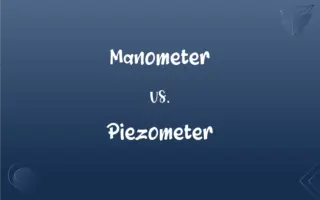Angular Acceleration vs. Centripetal Acceleration: What's the Difference?
Edited by Aimie Carlson || By Janet White || Published on January 5, 2024
Angular acceleration is the rate of change of angular velocity, while centripetal acceleration is the rate of change of velocity towards the center of a circular path.

Key Differences
Angular acceleration measures how quickly an object's rotational speed changes, typically expressed in radians per second squared. Centripetal acceleration, however, is the acceleration of an object moving in a circular path, directed towards the center of the circle.
An increase in angular acceleration means a faster change in rotational velocity. In contrast, centripetal acceleration is constant for uniform circular motion and is dependent on the object's speed and the radius of the circle.
Angular acceleration occurs in rotating systems like spinning wheels or planets rotating around their axes. Centripetal acceleration is experienced in any form of circular motion, such as a car turning around a curve or a satellite orbiting a planet.
The formula for angular acceleration is α = Δω/Δt, where Δω is the change in angular velocity, and Δt is the time taken for this change. Centripetal acceleration's formula is a_c = v²/r, where v is the linear speed and r is the radius of the circular path.
Angular acceleration is a vector quantity, having both magnitude and direction. Centripetal acceleration, while also a vector, always points towards the center of the circular path, perpendicular to the object's instantaneous velocity.
ADVERTISEMENT
Comparison Chart
Part of Speech
Noun
Noun
Number of Syllables
7 (an-gu-lar ac-cel-er-a-tion)
8 (cen-tri-pe-tal ac-cel-er-a-tion)
Usage in a Sentence
"The ice skater increased her angular acceleration by pulling in her arms."
"The centripetal acceleration keeps the moon in orbit around the Earth."
Common Associated Words
Rotation, radians, torque
Circular motion, radius, velocity
Derived Forms
Angularly (adverb), Accelerative (adjective)
Centripetally (adverb), Accelerative (adjective)
ADVERTISEMENT
Angular Acceleration and Centripetal Acceleration Definitions
Angular Acceleration
Angular acceleration can be influenced by external torques or forces.
Applying a force at the rim of the wheel altered its angular acceleration.
Centripetal Acceleration
It's a key concept in circular motion and rotational dynamics.
In the roller coaster loop, riders experience intense centripetal acceleration.
Angular Acceleration
It's a vector quantity describing how fast an object rotates or spins.
The angular acceleration of the Earth around its axis is quite consistent.
Centripetal Acceleration
This acceleration is crucial for maintaining circular motion.
The centripetal acceleration is what prevents satellites from flying off into space.
Angular Acceleration
Angular acceleration is the rate of change of angular velocity over time.
The fan's blades showed a marked increase in angular acceleration as they sped up.
Centripetal Acceleration
Centripetal acceleration is dependent on the object's speed and the radius of the path.
As the radius of the circle decreased, the centripetal acceleration increased.
Angular Acceleration
This term is used in physics to describe rotational motion dynamics.
In our experiment, we measured the angular acceleration of a rotating disc.
Centripetal Acceleration
Centripetal acceleration is the acceleration directed towards the center of a circular path.
The centripetal acceleration of a car going around a bend keeps it on the road.
Angular Acceleration
Angular acceleration applies to objects undergoing changes in rotational speed.
During the pirouette, the dancer's angular acceleration varied significantly.
Centripetal Acceleration
It's a measure of how quickly an object's velocity changes direction in circular motion.
A planet orbiting a star experiences continuous centripetal acceleration.
FAQs
Can angular acceleration be negative?
Yes, it's negative when rotational speed decreases.
What defines centripetal acceleration?
It's the acceleration directed toward the center of an object's circular path.
What causes angular acceleration?
It's caused by torque applied to a rotating object.
Is centripetal acceleration always directed inward?
Yes, it always points towards the center of the circular path.
Does angular acceleration depend on radius?
No, it depends on the rate of change of angular velocity.
How is angular acceleration measured?
It's measured in radians per second squared.
What is angular acceleration?
It's the rate at which an object's rotational speed changes.
What units are used for centripetal acceleration?
Centripetal acceleration is measured in meters per second squared.
What factors affect centripetal acceleration?
The object's speed and the radius of the circular path.
How does speed affect centripetal acceleration?
Greater speed results in greater centripetal acceleration.
How do you calculate angular acceleration?
It's calculated as the change in angular velocity divided by the time taken for that change.
What happens to centripetal acceleration if the radius increases?
It decreases as the radius of the circular path increases.
What role does mass play in angular acceleration?
Mass affects the moment of inertia, which influences angular acceleration.
Does mass affect centripetal acceleration?
Mass itself doesn't affect centripetal acceleration, but it does affect the force needed to achieve it.
Can an object have both angular and centripetal acceleration?
Yes, in scenarios like a car turning on a curved track.
Do angular and centripetal acceleration always occur together?
Not always; they occur together in rotational motion around a curved path but can exist independently.
Is angular acceleration relevant in linear motion?
No, it's specific to rotational motion.
Can centripetal acceleration exist in straight-line motion?
No, it's specific to circular or curved motion.
Are angular and centripetal acceleration related?
They're related in the context of rotational motion but describe different aspects.
How is centripetal acceleration calculated?
It's calculated using the formula v²/r, where v is linear velocity and r is the radius.
About Author
Written by
Janet WhiteJanet White has been an esteemed writer and blogger for Difference Wiki. Holding a Master's degree in Science and Medical Journalism from the prestigious Boston University, she has consistently demonstrated her expertise and passion for her field. When she's not immersed in her work, Janet relishes her time exercising, delving into a good book, and cherishing moments with friends and family.
Edited by
Aimie CarlsonAimie Carlson, holding a master's degree in English literature, is a fervent English language enthusiast. She lends her writing talents to Difference Wiki, a prominent website that specializes in comparisons, offering readers insightful analyses that both captivate and inform.






































































